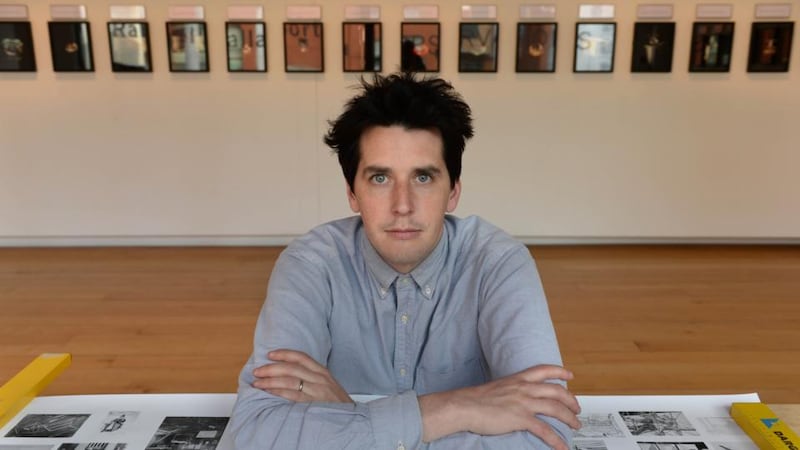Steadily their effect develops – from attractive, through intriguing and unsettling, to disturbing. Raphaël Dallaporta’s series of 35 photographs of landmines are a compelling testament to humanity’s ingenuity when it comes to devising ways to kill one another.
This is the French photographer’s first exhibition in Ireland, and it is one of those shows that works on you step by step: seducing, provoking, attacking and worrying. It’s the worry I’m left with. So I wonder, when I meet the artist, if he’s an optimist.
“I love contradiction,” he says. “Contradiction is the perfect word to enter my work. I don’t dream of a world more human at all. Human is a danger. I dream of a world more conscious, more spiritual, more responsible. There is some hope.”

Nevertheless, the exhibition, which features four distinct “episodes” in Dallaporta’s work, doesn’t necessarily inspire hope.
Fragile , made in collaboration with a forensic pathologist, shows the depredations of life and fatal chance on the human body. Ruins features photographs taken by a drone (purchased on the internet) flying over Afghanistan. Domestic Slavery is a series of banal shots of building facades. In that project, the text beside each image is the kicker, as it relates the stories of migrant workers kept as slaves within the buildings.
Luxury landmines
The centrepiece of the show, though, is Anti-Personnel , those images of landmines, shot as if they were luxury items, and accompanied by brief captions letting us know who made them, their capacities and their legacies.
Dallaporta, born in 1980, is one of an emerging generation of artists looking at war and violence through the prism, as he describes it, of two generations of relative peace in Europe. Another is Berliner Andreas Mühe, whose photo series Obersalzberg explores the spurious attractiveness of the trappings of power, and looks at why Nazism was able to fascinate.
A similar push-me-pull-you of enticement and repulsion is at play here. “I like to attract attention and the best way to attract attention is through beauty,” says Dallaporta. “So you put a beautiful light on an object, you can have a very beautiful aesthetic, even if the thing is not beautiful itself.”
Landmines are among the cheapest killing machines. There’s a photograph of a Chinese model in the exhibition that cost just $5 (€3.60). Dallaporta tells me that there are 110 million of these in the Chinese army’s stockpile.
The one thing that is absent from the images in the exhibition is people – if you don't count the body parts seen in the Fragile series. But the artist says they are present throughout.
“The people who think of it, design it, make money from it, all these are present, because they are there with the object, with the use and the abuse of it.”
Artists who make work around images of war and violence can tread difficult ethical ground. These include Richard Mosse, recently celebrated for his success representing Ireland at last year's Venice Biennale with The Enclave , which is on show at Ormston House, Limerick, until May 5th.
There’s something about the aestheticisation of violence, and its presentation in the sanitised context of an art gallery, that can put the viewer in a tricky position. The question is more complex when it comes to Mosse’s work, because his images involve people, including child soldiers, in the Congo.
Nagging questions
With Dallaporta it is more the nagging questions: what am I actually looking at and why? For the artist, the question of ethics is fundamental, and it is wrapped up in his sense of contradiction.
“We are able to do art, we are able to do great things. We are good at working together, doing things collectively, and these are very great things. But the thing we are able to do best is make weapons and destroy. But even this doesn’t scare me any more. I live with that. I think of it very often and develop it in my work.”
He also points out that his former career as a commercial photographer was far more lucrative than his present one as an artist. But art is what he wants to do.
“My goal was not to make a collection of the landmines, but to take an example of what humans have been able to do. So you have 50 years of recent conflict through these little objects. Nazi, Vietnam, South Africa . . . Some are old stock, but may be still on the ground, and there are new ones from countries that still haven’t signed [the anti-landmine treaty], like America.
“There was good hope with Obama, but they are making so much business with landmine cleaning and so much business by selling them too. So they have business in the problem and the solution.”
That’s the real value of an exhibition like this: beyond the shocking beauty of the presentation, beyond the repellent fascination it conjures, it’s the worry you’re left with and a new inability to ignore.
The artist, who cites photographers Richard Avedon and Robert Doisneau as influences, has just returned from a visit to Dublin's National Gallery when we meet, and he is blown away by Caravaggio's The Taking of Christ , which hangs there. "This narrative, in one rectangle, it is so powerful. It's not only the light, it's the composition – it's so modern, cinematographic. If you manage to tell a story that way, that's a good example."
In a perhaps particularly French way, he fundamentally believes that art and galleries matter.
“You produce work. You need to make it visible. A gallery is one [venue], a street is another, but when you want to make people read stories, then the gallery is perfect.” This time it’s true.
Raphaël Dallaporta's Observations is at the Gallery of Photography until May 15. galleryofphotography.ie












